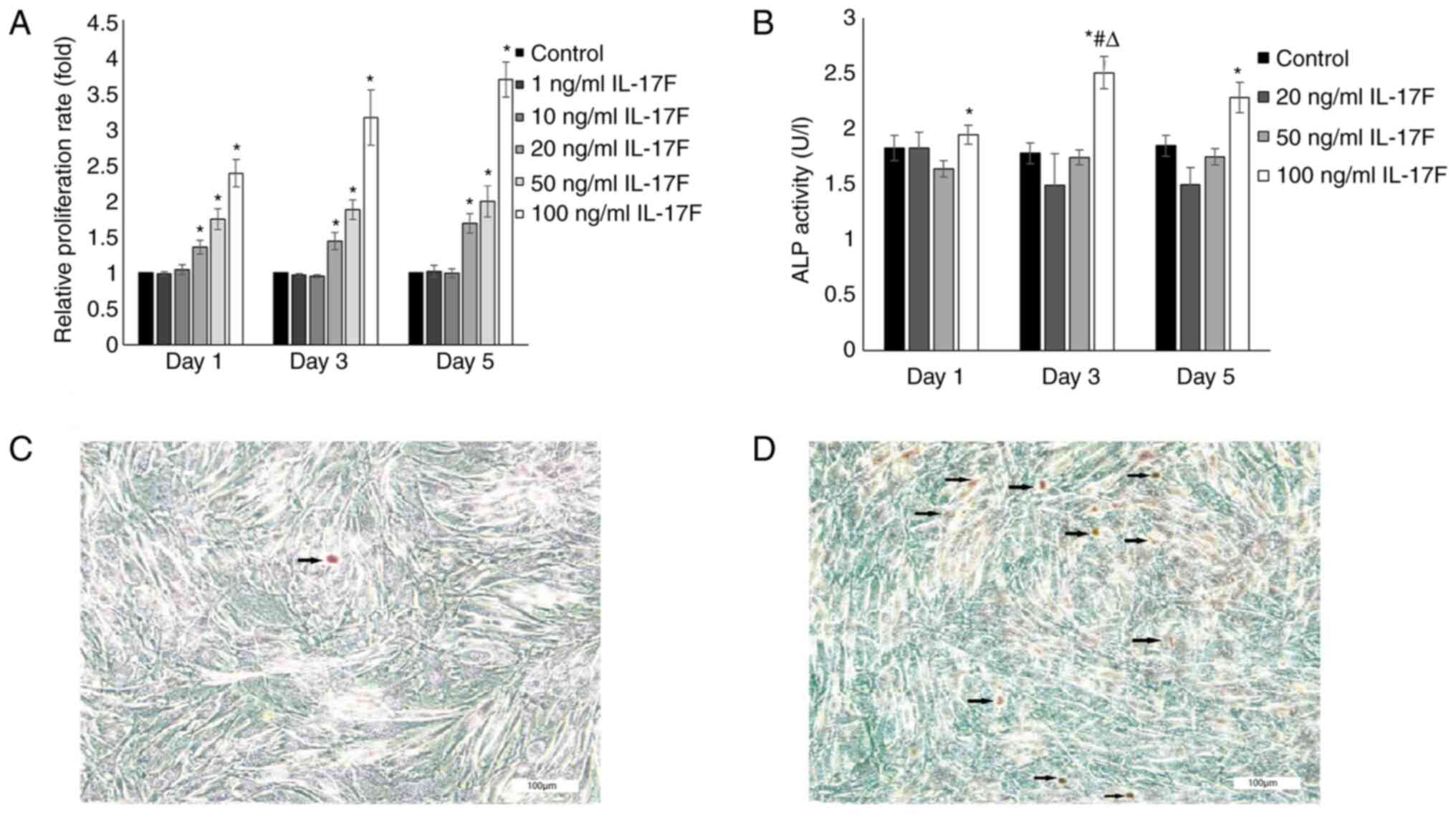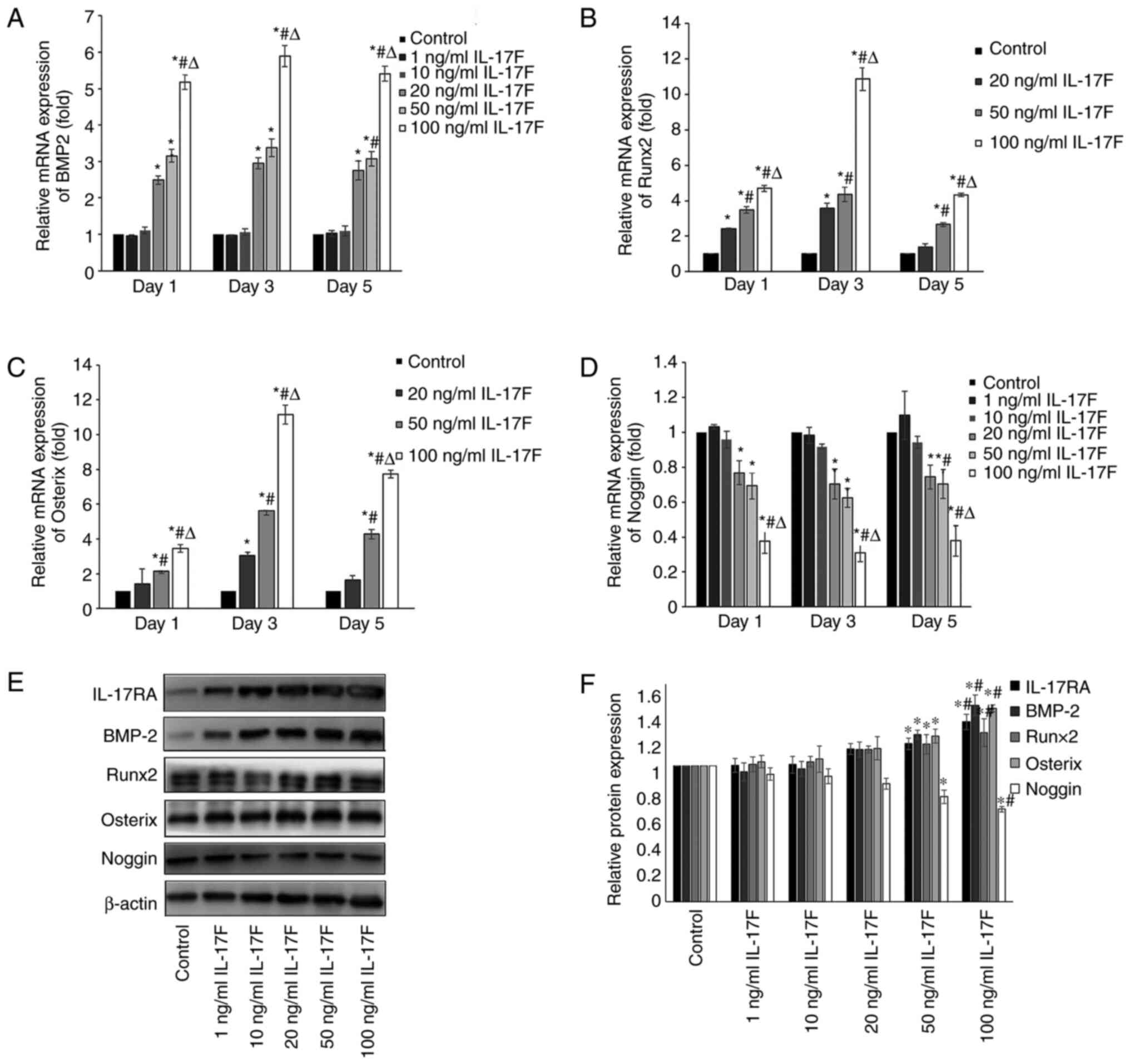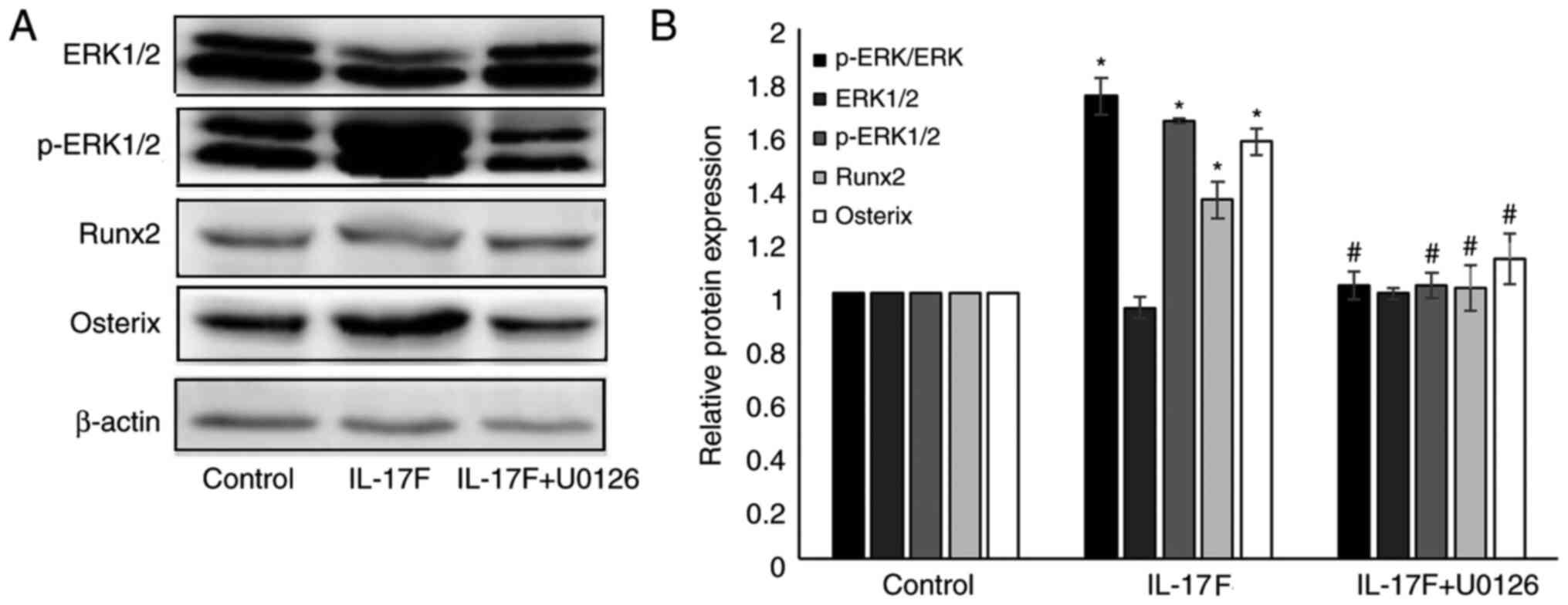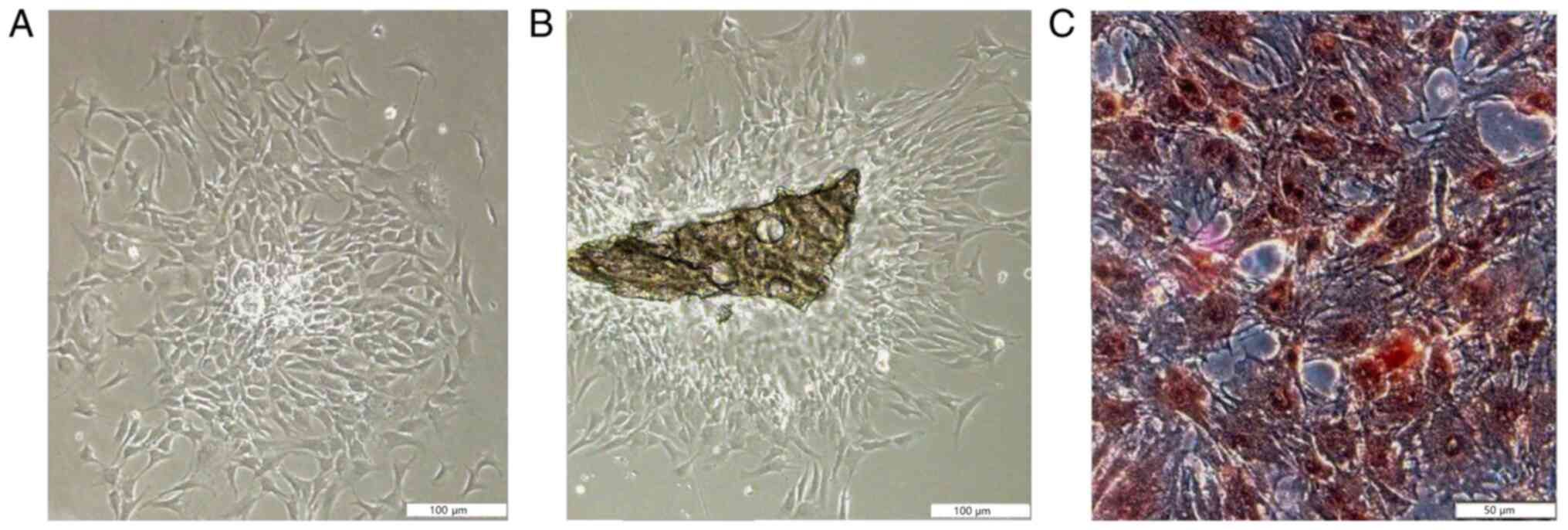|
1
|
Weitzmann MN and Pacifici R: Estrogen
deficiency and bone loss: An inflammatory tale. J Clin Invest.
116:1186–1194. 2006.PubMed/NCBI View
Article : Google Scholar
|
|
2
|
Harrington LE, Hatton RD, Mangan PR,
Turner H, Murphy TL, Murphy KM and Weaver CT: Interleukin
17-producing CD4+ effector T cells develop via a lineage distinct
from the T helper type 1 and 2 lineages. Nat Immunol. 6:1123–1132.
2005.PubMed/NCBI View
Article : Google Scholar
|
|
3
|
Chyuan IT and Chen JY: Role of
interleukin-(IL-) 17 in the pathogenesis and targeted therapies in
spondyloarthropathies. Mediators Inflamm.
2018(2403935)2018.PubMed/NCBI View Article : Google Scholar
|
|
4
|
Wu S, Meng Z and Zhang Y: Correlation
between rheumatoid arthritis and immunological changes in a
rheumatoid arthritis rat model. J Biol Regul Homeost Agents.
32:1461–1466. 2018.PubMed/NCBI
|
|
5
|
Koo BS, Jo S, Kwon E, Shin JH, Hur JW and
Kim TH: Effect of biologics in the level of cytokines in the
synovial fluid of patients with ankylosing spondylitis. Korean J
Intern Med. 35:465–473. 2020.PubMed/NCBI View Article : Google Scholar
|
|
6
|
Kim HJ, Seo SJ, Kim JY, Kim JY, Kim YG and
Lee Y: IL-17 promotes osteoblast differentiation, bone
regeneration, and remodeling in mice. Biochem Biophys Res Commun.
524:1044–1050. 2020.PubMed/NCBI View Article : Google Scholar
|
|
7
|
Miossec P and Kolls JK: Targeting IL-17
and TH17 cells in chronic inflammation. Nat Rev Drug Discov.
11:763–776. 2012.PubMed/NCBI View
Article : Google Scholar
|
|
8
|
Patel DD and Kuchroo VK: Th17 cell pathway
in human immunity: Lessons from genetics and therapeutic
interventions. Immunity. 43:1040–1051. 2015.PubMed/NCBI View Article : Google Scholar
|
|
9
|
Ono T, Okamoto K, Nakashima T, Nitta T,
Hori S, Iwakura Y and Takayanaqi H: IL-17 produing γδ T cells
enhance bone regeneration. Nat Commun. 7(10928)2016.PubMed/NCBI View Article : Google Scholar
|
|
10
|
Osta B, Lavocat F, Eljaafari A and Miossec
P: Effects of interleukin-17A on osteogenic differentiation of
isolated human mesenchymal stem cells. Front Immunol.
5(425)2014.PubMed/NCBI View Article : Google Scholar
|
|
11
|
Nam D, Mau E, Wang Y, Wright D, Silkstone
D, Whetstone H, Whyne C and Alman B: T-Lymphocytes enable
osteoblast maturation via IL-17F during the early phase of fracture
repair. PLoS One. 7(e40044)2012.PubMed/NCBI View Article : Google Scholar
|
|
12
|
Wang Y, Kim J, Chan A, Whyne C and Nam D:
A two phase regulation of bone regeneration: IL-17F mediates
osteoblastogenesis via C/EBP-β in vitro. Bone. 116:47–57.
2018.PubMed/NCBI View Article : Google Scholar
|
|
13
|
Vachhani K, Pagotto A, Wang Y, Whyne C and
Nam D: Design of experiments confirms optimization of lithium
administration parameters for enhanced fracture healing. J Biomech.
66:153–158. 2018.PubMed/NCBI View Article : Google Scholar
|
|
14
|
Yang W, Guo D, Harris MA, Cui Y,
Gluhak-Heinrich J, Wu J, Chen XD, Skinner C, Nyman JS, Edwards JR,
et al: Bmp2 in osteoblasts of periosteum and trabecular bone links
bone formation to vascularization and mesenchymal stem cells. J
Cell Sci. 126:4085–4098. 2013.PubMed/NCBI View Article : Google Scholar
|
|
15
|
Salazar VS, Gamer LW and Rosen V: BMP
signaling in skeletal development, disease and repair. Nat Rev
Endocrinol. 12:203–221. 2016.PubMed/NCBI View Article : Google Scholar
|
|
16
|
Cohen MM: Bone morphogenetic proteins with
some comments on fibrodysplasia ossificans progressive and NOGGIN.
Am J Med Genet. 109:87–92. 2002.PubMed/NCBI View Article : Google Scholar
|
|
17
|
Canalis E, Economides AN and Gazzerro E:
Bone morphogenetic proteins, their antagonists, and the skeleton.
Endocrine Rev. 24:218–235. 2003.PubMed/NCBI View Article : Google Scholar
|
|
18
|
Moffett SP, Dillon KA, Yerges LM, Goodrich
LJ, Nestlerode C, Bunker CH, Wheeler VW, Patrick AL and Zmuda JM:
Identification and association analysis of single nucleotide
polymorphisms in the human noggin (NOG) gene and osteoporosis
phenotypes. Bone. 44:999–1002. 2009.PubMed/NCBI View Article : Google Scholar
|
|
19
|
Komori T: Regulation of osteoblast
differentiation by transcription factors. J Cell Biochem.
99:1233–1239. 2006.PubMed/NCBI View Article : Google Scholar
|
|
20
|
Amatya N, Garg AV and Gaffen SL: IL-17
signaling: The Yin and the Yang. Trends Immunol. 38:310–322.
2017.PubMed/NCBI View Article : Google Scholar
|
|
21
|
Ely LK, Fischer S and Garcia KC:
Structural basis of receptor sharing by interleukin 17 cytokines.
Nat Immunol. 10:1245–1251. 2009.PubMed/NCBI View
Article : Google Scholar
|
|
22
|
Toy D, Kugler D, Wolfson M, Vanden Bos T,
Gurgel J, Derry J, Tocker J and Peschon J: Cutting edge:
Interleukin 17 signals through a heteromeric receptor complex. J
Immunol. 177:36–39. 2006.PubMed/NCBI View Article : Google Scholar
|
|
23
|
Gu C, Wu L and Li X: IL-17 family:
Cytokines, receptors and signaling. Cytokine. 64:477–485.
2013.PubMed/NCBI View Article : Google Scholar
|
|
24
|
Schwandner R, Yamaguchi K and Cao Z:
Requirement of tumor necrosis factor receptor-associated factor
(TRAF) 6 in interleukin 17 signal transduction. J Exp Med.
191:1233–1240. 2000.PubMed/NCBI View Article : Google Scholar
|
|
25
|
Nguyen TT, Lian S, Ung TT, Xia Y, Han JY
and Jung YD: Lithocholic acid stimulates IL-8 expression in human
colorectal cancer cells via activation of Erk1/2 MAPK and
Suppression of STAT3 Activity. J Cell Biochem. 118:2958–2967.
2017.PubMed/NCBI View Article : Google Scholar
|
|
26
|
Chen T, Huang H, Zhou Y, Geng L, Shen T,
Yin S, Zhou L and Zheng S: HJURP promotes hepatocellular carcinoma
proliferation by destabilizing p21 via the MAPK/ERK1/2 and
AKT/GSK3β signaling pathways. J Exp Clin Cancer Res.
37(193)2018.PubMed/NCBI View Article : Google Scholar
|
|
27
|
Chen Q, Xia T and Ye ZW: New SD Rat
osteoblasts by modified explant culture in vitro and
identification. Acta Universitatis Medicinalis Anhui. 47:1124–1127.
2006.
|
|
28
|
Sun L and Hou JM: Primary culture and
identification of rats cranial cover osteocytes. Med Innovation
China. 8:17–19. 2011.
|
|
29
|
Livak KJ and Schmittgen TD: Analysis of
relative gene expression data using real-time quantitative PCR and
the 2(-Delta Delta C(T)) method. Methods. 25:402–408.
2001.PubMed/NCBI View Article : Google Scholar
|
|
30
|
Orimo H: The mechanism of mineralization
and the role of alkaline phosphatase in health and disease. J
Nippon Med Sch. 77:4–12. 2010.PubMed/NCBI View Article : Google Scholar
|
|
31
|
Starnes T, Robertson MJ, Sledge G, Kelich
S, Nakshatri H, Broxmeyer HE and Hromas R: Cutting edge: IL-17F, a
novel cytokine selectively express in activated T cells and
monocytes, regulates angiogenesis and endothelial cell cytokine
production. J Immunol. 167:4137–4140. 2001.PubMed/NCBI View Article : Google Scholar
|
|
32
|
Kimura A and Kishimoto T: IL-6: Regulator
of Treg/Th17 balance. Eur J Immunol. 40:1830–1835. 2010.PubMed/NCBI View Article : Google Scholar
|
|
33
|
Paradowska-Gorycka A, Sowinska A,
Stypinska B, Grobelna MK, Walczyk M, Olesinska M, Piotrowski P and
Jagodzinski PP: Impact of the IL-17F, IL-23 and IL-23R on
susceptibility and phenotype of systemic lupus erythematosus.
Autoimmunity. 49:373–382. 2016.PubMed/NCBI View Article : Google Scholar
|
|
34
|
Soderstrom C, Berstein G, Zhang W, Valdez
H, Fitz L, Kuhn M and Fraser S: Ultra-sensitive measurement of
IL-17A and IL-17F in psoriasis patient serum and skin. AAPS J.
19:1218–1222. 2017.PubMed/NCBI View Article : Google Scholar
|
|
35
|
Hatta M, Surachmanto EE, Islam AA and
Wahid S: Expression of mRNA IL-17F and sIL-17F in atopic asthma
patients. BMC Res Notes. 10(202)2017.PubMed/NCBI View Article : Google Scholar
|
|
36
|
Gomes da Silva IIF, Angelo HD, Rushansky
E, Mariano MH, Diniz Maia MM and Eleuterio de Souza PRE:
Interleukin (IL)-23 Receptor, IL-17A and IL-17F gene polymorphisms
in brazilian patients with rheumatoid arthritis. Arch Immunol Ther
Exp (Warsz). 65:537–543. 2017.PubMed/NCBI View Article : Google Scholar
|
|
37
|
Wang H, Zhang Y, Liu Z, Zhang Y, Zhao H
and Du S: The IL-17A G-197A and IL-17F 7488T/C polymorphisms are
associated with increased risk of cancer in Asians: A
meta-analysis. Drug Des Devel Ther. 9:5159–5168. 2015.PubMed/NCBI View Article : Google Scholar
|
|
38
|
Erkolİnal E, Görükmez O, Eroğlu S, Özemri
SŞ, Solak Ö, Görükmez Ö and Yakut T: Associations between
polymorphisms of IL-17F and IL-17A genes with disease activity and
clinical outcome of Ankylosing Spondylitis. Acta Reumatol Port.
41:232–239. 2016.PubMed/NCBI
|
|
39
|
Luu HH, Song WX, Luo X, Manning D, Lou J,
Deng ZL, Sharff KA, Montag AG, Haydon RC and He TC: Distinct roles
of bone morphogenetic proteins in osteogenic differentiation of
mesenchymal stem cells. J Orthop Res. 2:665–677. 2007.PubMed/NCBI View Article : Google Scholar
|
|
40
|
Taşli PN, Aydin S, Yalvaç ME and Sahin F:
Bmp 2 and bmp 7 induce odonto- and osteogenesis of human tooth germ
stem cells. Appl Biochem Biotechnol. 172:3016–3025. 2014.PubMed/NCBI View Article : Google Scholar
|
|
41
|
Jimi E, Hirata S, Shin M, Yamazaki M and
Fukushima H: Molecular mechanisms of BMP-induced bone formation:
Cross-talk between BMP and NF-κB signaling pathways in
osteoblastogenesis. Jpn Dent Sci Rev. 46:33–42. 2010.
|
|
42
|
Moon SH, Kim I and Kim SH: Mollugin
enhances the osteogenic action of BMP-2 via the p38-Smad signaling
pathway. Arch Pharm Res. 40:1328–1335. 2017.PubMed/NCBI View Article : Google Scholar
|
|
43
|
Kim EC, Yoon SJ, Noh K and Lee DW: Dual
effect of curcumin/BMP-2 loaded in HA/PLL hydrogels on osteogenesis
in vitro and in vivo. J Nanosci Nanotechnol. 17:143–152.
2017.PubMed/NCBI View Article : Google Scholar
|
|
44
|
Sun WL, Wang N and Xu Y: Impact of
miR-302b on calcium-phosphorus metabolism and vascular
calcification of rats with chronic renal failure by regulating
BMP-2/Runx2/Osterix signaling pathway. Arch Med Res. 49:164–171.
2018.PubMed/NCBI View Article : Google Scholar
|
|
45
|
Yu X, Kawakami H, Tahara N, Olmer M,
Hayashi S, Akiyama R, Bagchi A, Lotz M and Kawakami Y: Expression
of Noggin and Gremlin1 and its implications in fine tuning BMP
activities in mouse cartilage tissues. J Orthop Res. 35:1671–1682.
2017.PubMed/NCBI View Article : Google Scholar
|
|
46
|
AlShaibi HF, Ahmed F, Buckle C, Fowles
ACM, Awlia J, Cecchini MG and Eaton C: The BMP antagonist Noggin is
produced by osteoblasts in response to the presence of prostate
cancer cells. Biotechnol Appl Biochem. 65:407–418. 2018.PubMed/NCBI View Article : Google Scholar
|
|
47
|
Yunan MA, Ying Y, Huanhuan S, Zhaozeng S,
Lin Z and Yunzhi FA: Effect of Noggin silencing on the BMP and Wnt
signaling pathways. Acta Laboratorium Animalis Scientia Sinica.
24:475–480. 2016.
|



















